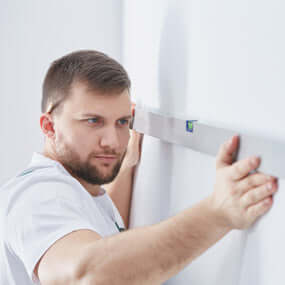When Mike looks at his garage, he sees potential. Not the chaotic mess of seasonal decorations, tangled garden hoses, and bikes leaning precariously against each other – but the organized, functional workspace he knows it could become. If you're like Mike, you've probably discovered that slatwall systems offer one of the most versatile solutions for garage organization. (Not convinced yet? See our article on choosing Slatwall for wall storage). But here's what most homeowners don't realize until it's too late: not all slatwall materials are created equal, and choosing the wrong type can turn your smart $500 investment into a costly $2,000 mistake.
The secret lies in understanding three critical material properties that separate the winners from the disasters: strength, durability in garage environments, and total cost of ownership. Get these wrong, and you'll be replacing your entire system within two years. Get them right, and you'll have a storage solution that grows with your needs for decades.
Only Some Kinds of Slatwall Are Strong Enough

Take that garden hose coiled up in the corner. Seems innocent enough, right? A standard 100-foot garden hose weighs between 12-15 pounds when dry. Add water, and you're looking at 20-25 pounds of dead weight hanging from your wall. Even worse, it gets hung on a hook that extends 8"-10" out from the wall which multiplies that weight. Now think about everything else you're planning to hang; your mountain bike (25-30 pounds), power tools, sports equipment, and golf bags. Take any of those and be less-than-gentle dropping them onto a hook on MDF, and you will break something.
Mike learned this the hard way when his first MDF slatwall system sagged under the weight of two bicycles and a ladder after just six months. The 30-50 pound load capacity of standard MDF slatwall might be adequate to display clothes in a retail shop, but it's barely sufficient for garage storage needs.
Here's a truth every homeowner discovers: the amount of stuff you store always grows and never diminishes. What starts as a simple bike and hose storage solution gradually accumulates lawn equipment, camping gear, holiday decorations, and "temporary" items that become permanent residents.
This storage creep means your slatwall needs to handle not just today's load, but tomorrow's expansion. PVC slatwall systems, with their 75-100 pound per square foot capacity, provide the headroom you need. Steel and aluminum systems go even higher at 100-200 pounds per square foot, but as we'll explore, they come with their own cost considerations.
Only Some Kinds of Slatwall Will Last in a Garage Environment
Garages are moisture magnets. From morning dew on vehicles to humidity changes throughout seasons, your garage experiences more moisture fluctuations than any other part of your home. This spells disaster for MDF (Medium Density Fiberboard) slatwall systems.

MDF is essentially wood fiber held together with resin and adhesive. When exposed to moisture, these fibers absorb water like a sponge, causing the material to swell, warp, and eventually delaminate. Once MDF gets wet, the damage is permanent and irreversible. You've seen this in bathroom vanities and cheap furniture – the same thing happens to MDF slatwall in garage environments.
PVC slatwall, by contrast, is completely waterproof. It won't absorb moisture, won't grow mold or mildew, and maintains its structural integrity regardless of humidity levels. This moisture resistance alone can save you hundreds of dollars in replacement costs.
Garages are working environments. Tools get dropped, car doors get opened too far, equipment gets moved around, and accidents happen. MDF slatwall can't handle this kind of abuse. A dropped wrench or mishandled ladder can leave permanent dents, chips, and gouges that can't be repaired.

The core problem with MDF is that it's not solid material – it's compressed fiber. When damaged, you can't sand it smooth like solid wood because you'll expose the different-colored core material underneath. Paint touch-ups look obvious and amateur.
PVC slatwall handles impacts much better. Its color goes all the way through the material, so surface scratches blend in rather than standing out. While it's not indestructible, minor damage is far less noticeable and doesn't compromise the system's integrity.

Garages often house flammable materials: gasoline, oil, paint, and hot cars. That's the reason building codes in most areas require thicker drywall on garage walls connected to the living space. Putting a flammable wall covering over that drywall isn't a great idea. Quality PVC slatwall systems carry a Grade A rating for flame spread, meaning the lowest possible danger during a fire.
MDF, being wood-based, is inherently flammable. While it may be treated with fire retardants, it still poses a greater fire risk than PVC alternatives and is typically rated Class C. Steel and aluminum systems offer excellent fire resistance but come with their own installation and cost challenges.
Only Some Kinds of Slatwall Are Not Crazy Expensive
Steel and aluminum slatwall systems are undeniably impressive and if you're spending someone else's money, go for it. They're incredibly strong, durable, and have a premium appearance that screams "professional grade." They're also incredibly expensive – typically running over $1000 for a 32 square foot installation compared to $250-300 for equivalent PVC systems.

For most homeowners, this price difference represents poor value. Unless you're storing extremely heavy items or prioritize the industrial aesthetic, PVC slatwall delivers 80% of the performance at 25% of the cost. That's money better spent on slatwall accessories, organization systems, or other garage improvements.
Here's a hidden cost that catches many homeowners off-guard: shipping large panels. Standard slatwall panels measure 4x8 feet; this size means they have to ship by freight rather than the less expensive parcel delivery firms such as FedEx. Even if your vendor offers free shipping, the cost of the freight is often buried in a higher price.

Many suppliers reduce shipping costs by offering smaller panel sizes, and that is a good option. Not only is the shipping cost reduced, but install is easier since the smaller panels are more friendly for a one person install- follow our slatwall installation guide for best results.
Since a piece of MDF is much heavier than the same size piece of PVC, the total delivered cost – including shipping – often pushes MDF systems into the same price range as PVC, making the choice obvious when you factor in durability and performance differences.
Material Comparison: The Numbers Don't Lie
| Material | Strength | Durability | Cost Range | Moisture Resistance | Fire Rating | Repairability |
|---|---|---|---|---|---|---|
| MDF (Wood-based) | 30-50 lbs/sq ft | $ | Poor - absorbs moisture | Damage is permanent/ visible | ||
| PVC/Plastic | 75-100 lbs/sq ft | $$ | Waterproof | Surface scratches blend in | ||
| Steel / Aluminum | 100-200 lbs/sq ft | $$$$ | Good - Rust resistant | Durable, minimal damage |
When you analyze the three main slatwall categories across the factors that matter most for garage applications, PVC emerges as the clear winner for most homeowners:
Strength: PVC systems typically handle 75-100 lbs per square foot – more than adequate for typical garage storage needs. MDF systems max out at 30-50 lbs per square foot, while steel/aluminum systems can handle 100-200+ lbs per square foot.
Durability: PVC offers excellent moisture resistance, impact tolerance, and flame retardancy. MDF performs poorly in all these categories, while steel/aluminum excels but at a premium price.
Cost: PVC provides the best value proposition at $250-300 per 32 square feet. MDF appears cheaper at $200-250 but requires replacement much sooner. Steel/aluminum systems cost $1000 and beyond.
For the typical homeowner storing bikes, tools, sports equipment, and seasonal items, PVC slatwall panels hits the sweet spot of performance, durability, and value.
Conclusion
The difference between a smart storage investment and an expensive mistake comes down to choosing the right material for your specific needs and environment. While MDF slatwall might seem like a budget-friendly option, its poor performance in garage environments makes it a false economy. Steel and aluminum systems offer premium performance but at premium prices that most homeowners can't justify.
PVC slatwall delivers the Goldilocks solution: strong enough for typical garage storage needs, durable enough to handle garage environments, and affordable enough to make financial sense. PVC that is strong enough for durable garage flooring is also strong enough for garage slatwall. When you factor in longevity, performance, and total cost of ownership, PVC slatwall represents the best value for most garage organization projects.
The choice isn't just about today's storage needs – it's about creating a system that will serve you reliably for decades to come, avoiding the pitfalls common in many garage organization projects. Choose wisely, and your garage organization system will be an investment that pays dividends every time you walk into your well-organized space. Choose poorly, and you'll be explaining to your spouse why you need to spend another $2,000 to fix a $500 mistake.





